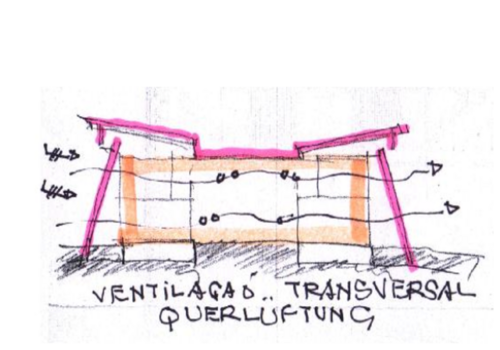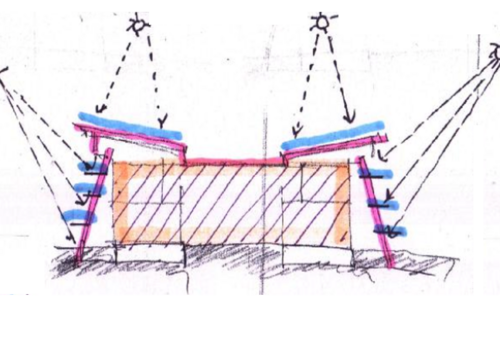Sustainability
Sustainable operation of the OSCM is key and has been actively implemented since its conception. Right from the start, the aim was to create a facility that self-generates the energy required to run all of its operations as well as to consume resources in a sustainable way. To achieve this goal, the architect made use of two renewable resources that are plentiful in Cabo Verde: the wind and the sun. To maximise the benefits of these abundant resources, the architect created a unique roof construction, which serves multiple functions and is the key for the sustainable management of the OSCM. The visually stunning roof provides indoor cooling from the prevailing trade winds. The elevated roof is separated from the actual body of the building and allows the trade winds to pass underneath the roof and thereby provide cooling to the shaded building. In addition, staggered wooden shading wings are installed in the building façade to prevent direct heating of the building corpus by sunrays while still allowing an unobstructed view from the inside. This clever harvesting of the trade winds and shading from direct sun allows an efficient climate control of the facility with minimal artificial, energy-consuming climatisation. Central air-conditioning systems have only been integrated in rooms that require a constant temperature, such as laboratories, cold storage rooms and seminar rooms.
To provide power for the building systems, the roof is equipped with a photovoltaic solar power system generating energy. The 50 kWp (kilowatt peak) system covers the OSCM's energy consumption and feeds the excess energy generated into the local power grid of Mindelo.
A look at the energy balance for 2020 shows how well the wind-driven and thus energy-efficient cooling and the solar power production work. Over 2020, the OSCM was fully autonomous in its energy footprint, and it produced more energy than it consumed.
Another great benefit of the clever roof design is the ability to collect rainwater. Due to the pitch of the roof, rainfall, which can be particularly intense in the rainy season, is collected and channelled to the centre of the building. From there, the collected rainwater is directed into the on-site cisterns and stored. This rainwater is used for sustainable watering of plantings at the OSCM site as well as for basic maintenance work such as rinsing equipment and instruments that have been exposed to salty seawater.
In addition to the self-sufficient energy balance and the careful use of water, the OSCM focuses on organising sustainable events. For instance, special care is taken during events to avoid the usage of any single-use plastic tableware and to strongly limit the use of plastic in other areas as well. Water is provided from large refillable containers instead of small dispensable plastic bottles. To complement the concept, special care is taken at events to ensure that guests are served locally produced food with vegetarian and vegan options.




